Understanding different types of staging in theatre is essential for GCSE Drama success. The layout of a performance space affects everything from how actors move, to how the audience connects with the story. Whether you’re performing Macbeth, devising a site-specific piece, or tackling exam questions, the staging you choose matters.
This article introduces seven main types of staging in theatre, with examples, classroom tips, and ways to help students meet GCSE Drama assessment criteria. By the end, you’ll feel confident choosing the right staging for any scene—and just as confident writing about it in your exam.
Why staging matters in theatre
Staging is more than where people stand. It’s about shaping energy, connection, and meaning. When students understand how staging influences a performance, their creative decisions become more focused—and their marks often go up too because they can make informed evaluations about the staging of live theatre for their live reviews and their own devised pieces.
As a teacher or student, ask yourself:
- What’s the style or tone of the play?
- What atmosphere do I want to create?
- What space do I have to work with?
Choosing the right staging type can unlock creative potential and improve both practical performance and written evaluations.
The 8 key types of staging in theatre
Here are the main staging types that GCSE Drama students should know, each with clear examples and classroom strategies.
1. Proscenium arch staging
This is the most traditional theatre setup. The audience sits on one side, facing a framed stage like a giant picture.
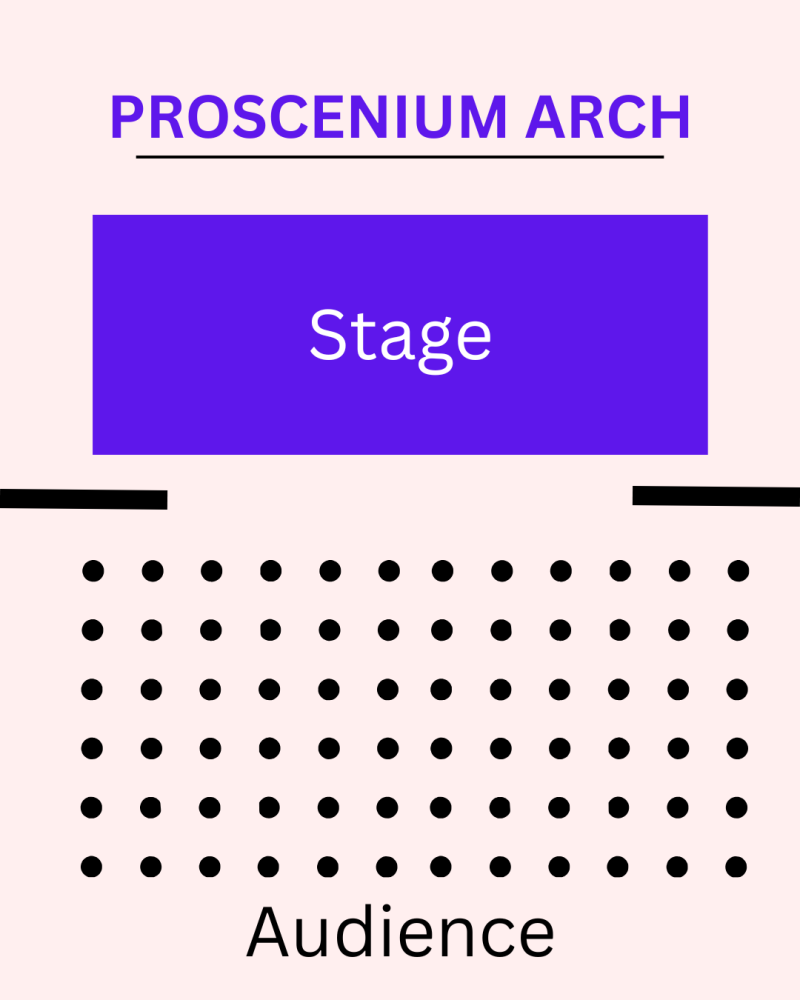
🎭 Why use it?
Great for realism, large sets, hidden scene changes, and detailed lighting design.
📚 Example:
An Inspector Calls works well on a proscenium stage. You can build a naturalistic dining room set and create visual focus.
🧠 GCSE tip:
Ideal for plays that require scene changes and controlled blocking. Remind students to “cheat out” and use projection.

Tibbits Opera House stage and proscenium from balcony. Photo by Pajameson – Template:Tibbits Opera House Archives, Public Domain, https://commons.wikimedia.org/w/index.php?curid=11091827
2. End-on staging
Similar to a proscenium layout, but without the formal frame. Often used in black box studios or school halls.
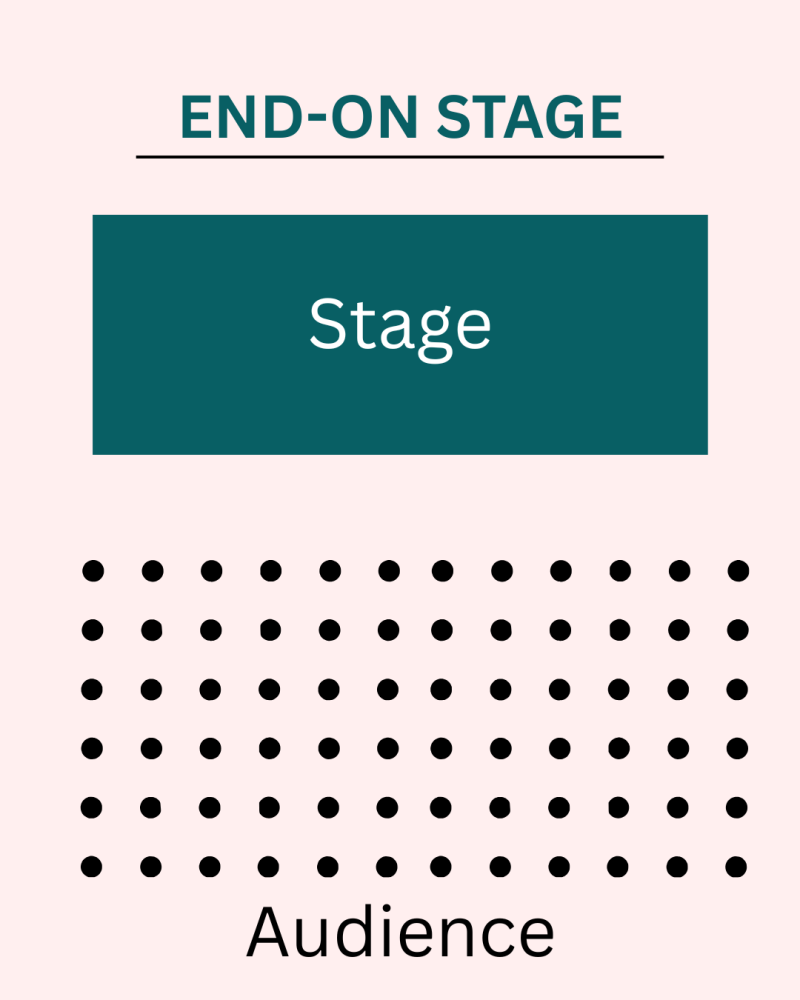
🎭 Why use it?
Simple, flexible, and easy to rehearse in small spaces. Focuses audience attention in one direction.
📚 Example:
DNA by Dennis Kelly can be performed end-on with minimal set and lighting for a stark, modern effect.
🧠 GCSE tip:
Perfect for low-tech setups. Students still need to manage sightlines and project clearly.
3. Thrust staging
The stage extends into the audience, who sit on three sides. Actors perform with more audience contact, but some backstage space remains.
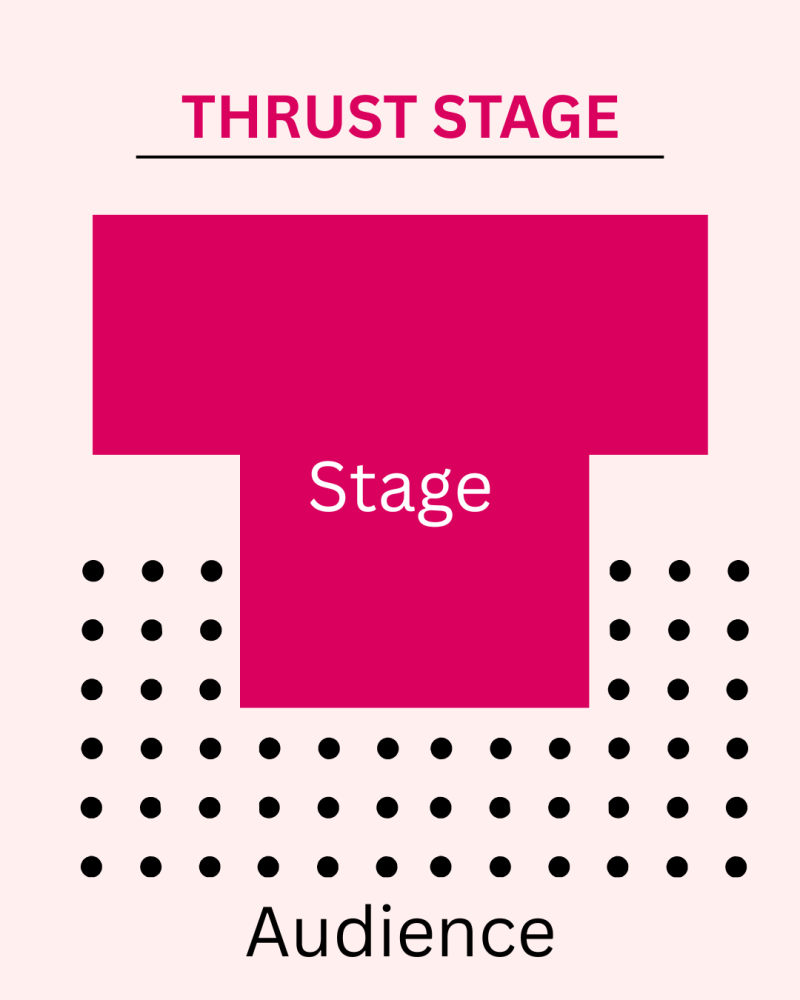
🎭 Why use it?
Creates intimacy while maintaining some traditional structure.
📚 Example:
Macbeth on a thrust stage allows witches to appear through the crowd and brings tension up close.
🧠 GCSE tip:
Sightlines matter—block movement carefully so no one gets left out visually.
4. Traverse staging
Also called an alley stage, this layout places the audience on two sides facing each other. The performance runs between them, like a runway.

🎭 Why use it?
Excellent for movement, confrontation scenes, or long, narrow spaces.
📚 Example:
Bouncers by John Godber could be staged traverse-style to mirror a nightclub queue.
🧠 GCSE tip:
Actors need to keep moving and play to both sides. Use tape to help plan positions in rehearsal.
5. Theatre in the round
The audience completely surrounds the stage, which often creates a more immersive and communal feel.

🎭 Why use it?
Fantastic for ensemble work and character-driven performances.
📚 Example:
Blue Remembered Hills by Dennis Potter benefits from in-the-round staging, bringing playground action close to the viewer.
🧠 GCSE tip:
There’s nowhere to hide! But that’s good—students stay focused, energised, and committed.
6. Site-specific staging
This takes place in a real-world location that supports the theme or setting of the piece—anything from a stairwell to a church or a park.
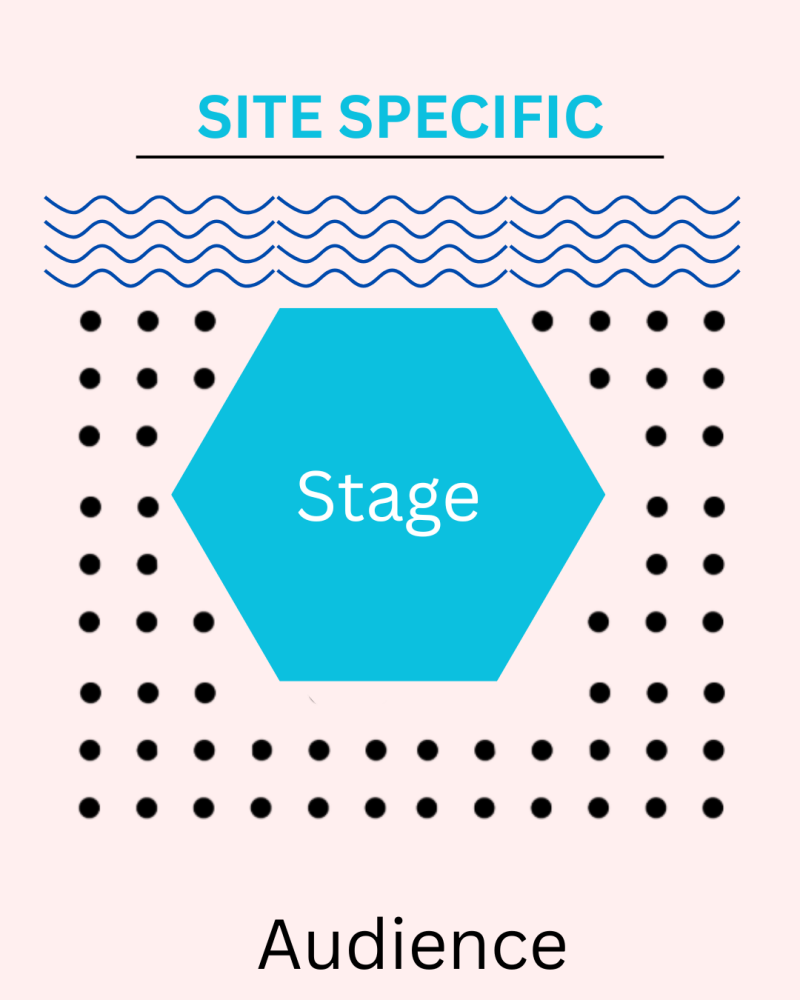
🎭 Why use it?
Highly immersive and meaningful. Great for devised pieces with a clear concept.
📚 Example:
A play exploring isolation set in a disused shopping centre can make the theme more powerful.
🧠 GCSE tip:
Encourage planning for practical factors: weather, acoustics, movement, and audience safety.
7. Promenade staging
In promenade theatre, the audience moves between scenes or locations during the performance. Actors and viewers share the space dynamically.
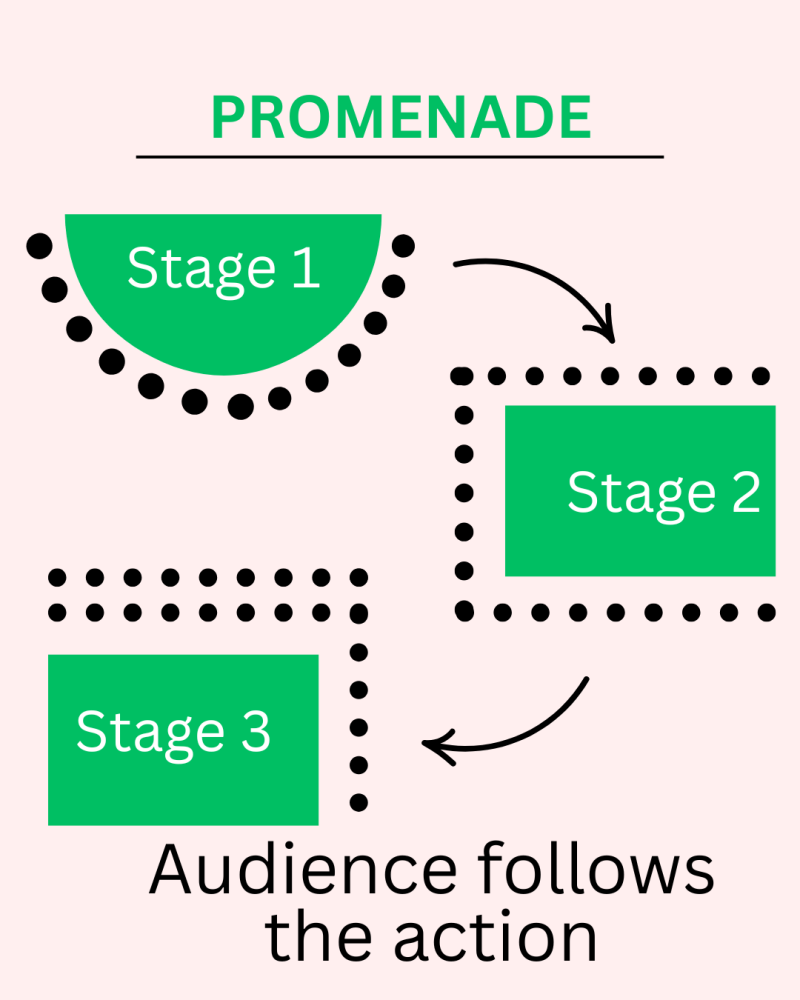
🎭 Why use it?
Ideal for “journey” narratives or fragmented scenes.
📚 Example:
A GCSE devised piece on grief might take the audience through different “rooms” representing memory, loss, and acceptance.
🧠 GCSE tip:
Think creatively about transitions, guides, and maintaining narrative flow even as the audience moves.
8. Amphitheatre staging
Amphitheatres are large, open-air venues with tiered seating, often semi-circular or oval, surrounding the stage. Originally used in Ancient Greece and Rome, this form is still popular in outdoor drama festivals.
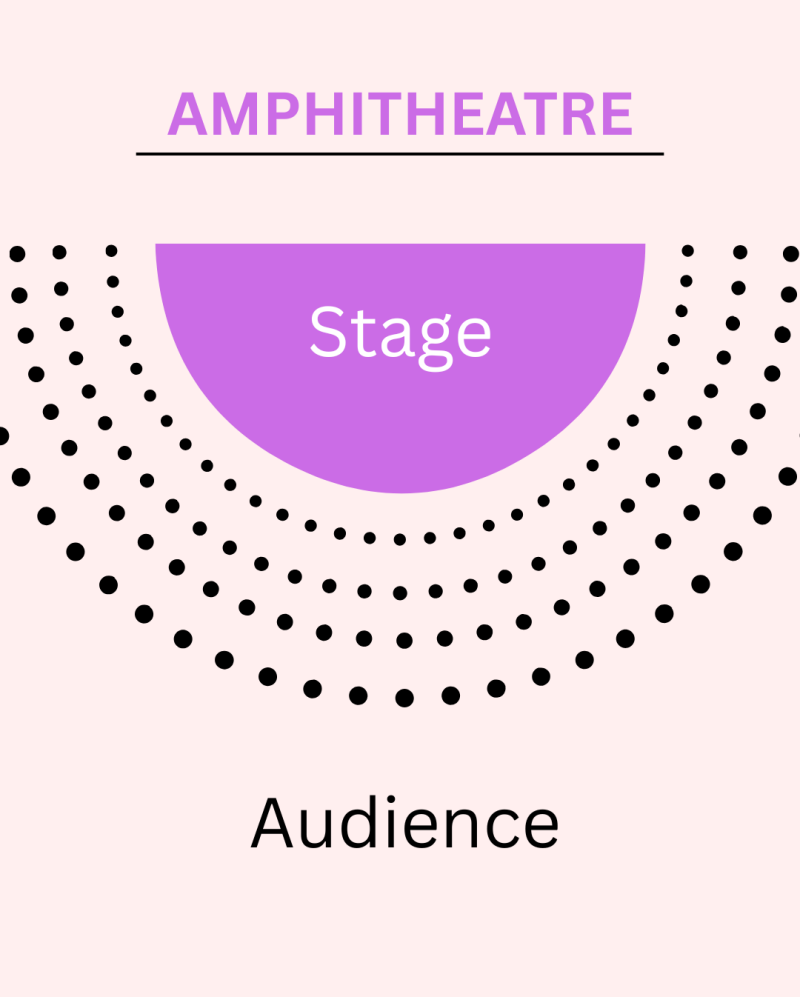
🎭 Why use it?
Great for large-scale or classical performances, especially those that embrace chorus work, projection, and natural settings.
📚 Example:
Performing a Greek tragedy like Antigone or Medea outdoors, with a chorus moving between the audience and the stage area.
🧠 GCSE tip:
Focus on voice projection and clear physical storytelling. Consider how movement and blocking can be seen from multiple angles, and how sound travels in open spaces.
Quick revision table – types of staging in theatre
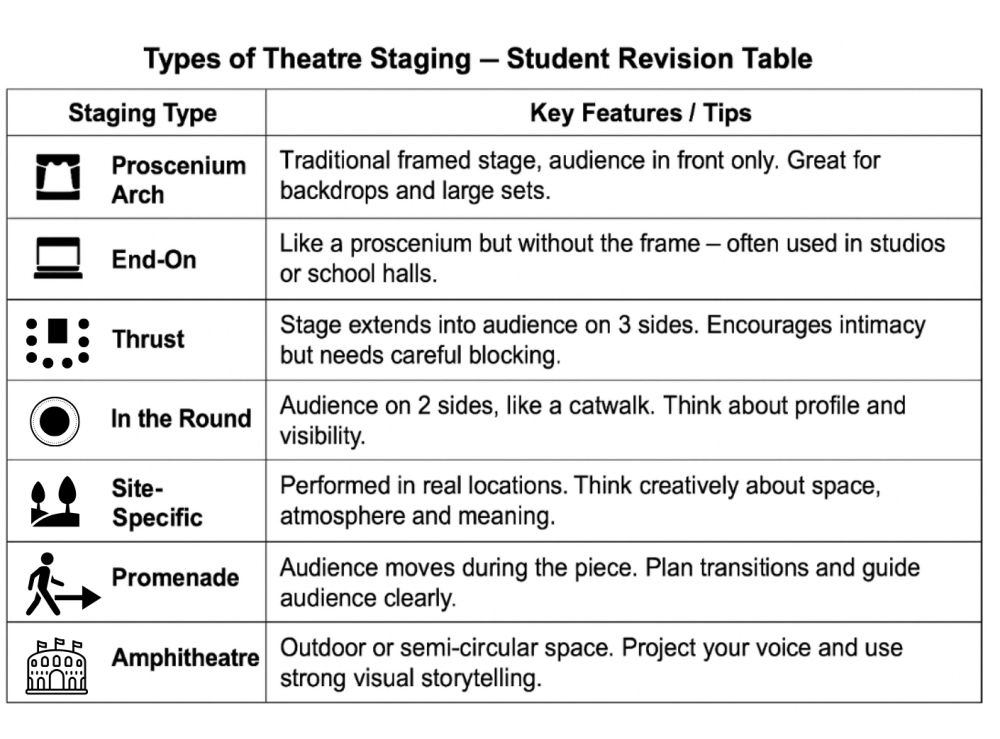
Staging in the written exam
GCSE Drama students are expected to:
- Name the stage type (e.g. “traverse staging”)
- Justify their choice clearly
- Explain how it affects audience experience and dramatic impact
Example:
“I would use thrust staging to bring the audience closer to the conflict and create a more intense atmosphere in the scene.”
Encourage students to connect staging decisions with character, theme, space, and design choices wherever possible.
How each staging type works in practice
Each staging type has its own uses, strengths, and things to watch out for. Here’s how they break down, along with some GCSE Drama examples.
Staging tips for GCSE drama lessons
Here are some key tips I share with students to help them make the most of staging choices in lessons and performances:
- Always check which way the audience will see the action. For in the round and traverse, actors should keep moving and try out different positions. Diagnoal blocking works well in the round, setting pairs of actors diagonally opposite each other.
- Remember the sightlines. Make sure everyone watching can see the most important action at all times.
- Plan entrances and exits with care. With thrust, traverse, and in the round, actors might enter from more than just stage right and stage left.
- Consider how sets and props work. Large pieces can block views in the round, so I suggest using smaller, flexible props whenever possible.
- Encourage students to rehearse facing different directions and sharing scenes with all members of the audience. Mixing it up can make performances more engaging for everyone.
Common challenges and how to make staging work
Each staging option comes with its own set of challenges. Over the years, I have picked up a few strategies to help solve these problems and keep rehearsals on track:
- Voice projection: In traverse and round setups, actors face away from some audience members at times. Practicing voice projection and making their voices reach all corners is vital. I like to use vocal warmups and exercises to build this skill.
- Movement and blocking: When using the round or traverse arrangement, planned movements are needed to ensure the action is visible from every direction. Marking the stage with tape during rehearsals can really help actors find their positions.
- Set design: Large sets often don’t work except on a proscenium stage. For thrust, traverse, or round arrangements, keep scenery to a minimum, and use multipurpose props as much as possible.
- Entrances and exits: In round or traverse staging, actors can enter from lots of directions. It’s great to encourage creativity and let students experiment with different entrance routes until each one feels natural on stage.
Applying stage types to exam questions
When students prepare for the written part of GCSE Drama exams, they’re often asked to refer to staging types by name. I always encourage them to name the stage clearly (like, “I would use theatre in the round”), connect their choice to the text or scene, and say how it helps build mood or audience connection.
Sample answer: “I would use thrust staging for this scene to allow performers to move nearer to the audience, making the tension feel more immediate and involving the viewers more in what’s happening.”
Some schools have flexible spaces, so getting students comfortable with all main staging types means they’re ready for any room, both in practical work and written papers. Don’t be afraid to try different styles—even just for one scene to see how it changes the effect!
Frequently asked questions
Here are some of the top questions about staging from GCSE classes and some quick answers to help you out:
Which type of stage is best for big sets and realistic drama?
Proscenium arch is usually best, as it allows for elaborate scenery without blocking anyone’s view.
How do I stop my back facing the audience all the time?
Practice moving in arcs, turning your whole body instead of just your head, and remember to share your focus equally with everyone around you, especially if you’re on a thrust or in the round stage.
Can I use traverse or theatre in the round for any play?
You can adapt almost any play for whatever staging type you have, but some plays suit certain types better depending on atmosphere and the way scenes need to reach the audience.
Do I have to use special set pieces for certain stage types?
No—but for traverse and round setups, simple, lightweight, and low furniture or props work best so no one’s view gets blocked.
Conclusion and free gift!
Choosing the right kind of staging can transform your GCSE drama work. Experimenting with different stage layouts helps students see what works for different scenes and styles, and encourages creative thinking. Making thoughtful choices and being able to explain them clearly is a skill that boosts both practical and written exam work. Try mixing it up, let students explore, and you’ll soon spot how the right staging setup can give your next project.
To make things easier, we’ve created a FREE, downloadable infographic which you can print out and put up in your classrooms or give to your students as revision.
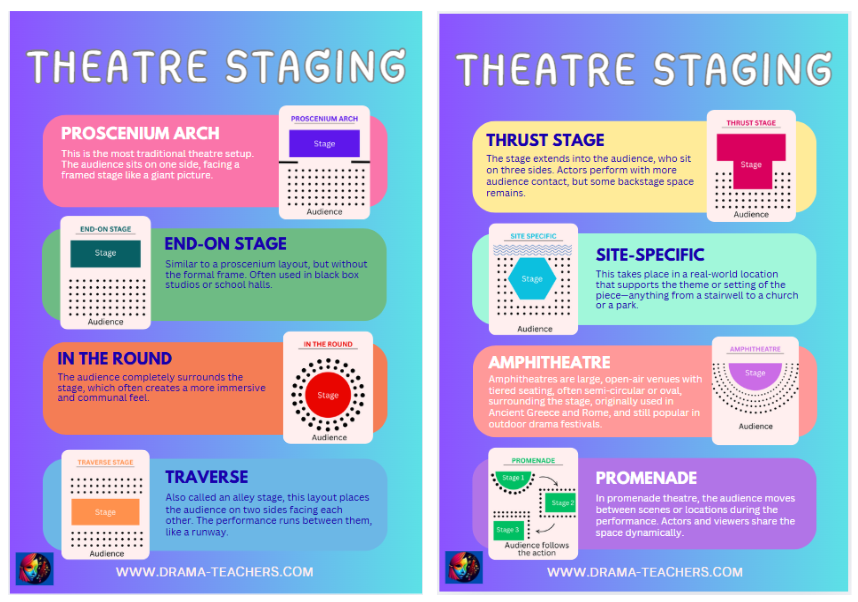
Related posts
Drama practitioners: Icons of the stage
Teacher’s guide to The Glass Menagerie
Drama timeline and ‘isms’ explained



You are right, staging can make or break a production. It’s about making relevant pictures on the stage that match the theme or story you are portraying. We are currently doing a singing and dancing show and because of random poles on the stage we have had to change the centre of the stage and move it slightly to the right. This imbalance hurts my eyes, but we are going to fill out the unused section with draping to try and balance it out.
Thrust staging can be very effective in including your audience in the story if you use it properly. I love using stages like this as you can project outwards from the stage into your audience. This works well if you want to involve your audience in the production, for instance a melodrama.
Hi Michel. Thanks for reading and commenting on the post. I’m interested to hear that you are making creative use of poles in them middle of a stage! They can be a real problem, especially for dance shows where you need the room to move freely. But it sounds like you will make the most of it with some creative draping! I used to work in the round quite a lot which can be a challenge to ensure everyone sees and hears properly but it’s also great for involving the audience as you do using a thrust stage. I’ve also done some interesting site specific work which is great fun and a change from the run-of-the-mill end-on or proscenium set ups.
Let me know how your dance and singing show goes. All the best. Gail
Hello Gail,
Thank you for taking the time to put together such a well-structured and insightful article.
What stood out to me most was how clearly each staging type was explained, paired with practical classroom tips and relatable examples.
It really demonstrates how thoughtful staging choices can transform a performance and create a deeper connection with the audience.
I do have a quick question: In your experience, which type of staging do students find most creatively liberating when devising their own original pieces, and why?
In my view, your article is a valuable resource for both students and educators.
Thank you again for sharing it.
Kind regards,
Makinde
Hi Makinde. Thanks so much for your kind comments and I’m very pleased that you like the article and think it will be useful to teachers and students alike. It’s a part of the GCSE syllabus here so it’s all good information to know. Most school halls have either a proscenium arch stage, or just a drama studio but I have encouraged students to experiment, especially in their devising pieces. I think they like in the round a lot, as they can really interact with the audience. I have done some site specific performances moving between different venues around school such as the stairwell, the library, the drama studio and the playground. That was a lot of fun and the students really enjoyed the challenge of it too, so it’s a good one to try if you can.